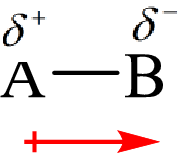
Concept explainers
(a)
Interpretation:
The depiction that best illustrates the change in molecular shape around
Concept introduction:
The following steps are used to determine the molecular shape of the given molecule.
Step 1: Write the Lewis structure of the given formula and place the atoms.
Step 2: Count all electron groups including bonding and non-bonding pairs around the central atom and use it to assign one of the five electron-group arrangement.
Step 3: Write the ideal bond angle related to the electron-group arrangement and the effect of any deviation can be predicted by using VSEPR.
Step 4: Count the bonding and non-bonding electron groups and draw the molecular shape accordingly.
(b)
Interpretation:
Whether the molecular polarity changes in the given reaction or not is to be determined.
Concept introduction:
The dipole moment arises when there is a separation of charges between two ions or atoms involved in the bond. The dipole moment is a vector quantity and its direction towards the most electronegative atom.
The direction of the dipole moment is represented as follows:

The polar and non-polar molecule can be identified on the basis of the net dipole moment. Polar molecules have non zero value of net dipole moment and the nonpolar molecules have zero net dipole moment.
Want to see the full answer?
Check out a sample textbook solution
Chapter 10 Solutions
MOLECULAR NATURE OF MATTER ALEKS ACCESS
- This deals with synthetic organic chemistry. Please fill in the blanks appropriately.arrow_forwardUse the References to access important values if needed for this question. What is the IUPAC name of each of the the following? 0 CH3CHCNH₂ CH3 CH3CHCNHCH2CH3 CH3arrow_forwardYou have now performed a liquid-liquid extraction protocol in Experiment 4. In doing so, you manipulated and exploited the acid-base chemistry of one or more of the compounds in your mixture to facilitate their separation into different phases. The key to understanding how liquid- liquid extractions work is by knowing which layer a compound is in, and in what protonation state. The following liquid-liquid extraction is different from the one you performed in Experiment 4, but it uses the same type of logic. Your task is to show how to separate apart Compound A and Compound B. . Complete the following flowchart of a liquid-liquid extraction. Handwritten work is encouraged. • Draw by hand (neatly) only the appropriate organic compound(s) in the boxes. . Specify the reagent(s)/chemicals (name is fine) and concentration as required in Boxes 4 and 5. • Box 7a requires the solvent (name is fine). • Box 7b requires one inorganic compound. • You can neatly complete this assignment by hand and…arrow_forward
- b) Elucidate compound D w) mt at 170 nd shows c-1 stretch at 550cm;' The compound has the ff electronic transitions: 0%o* and no a* 1H NMR Spectrum (CDCl3, 400 MHz) 3.5 3.0 2.5 2.0 1.5 1.0 0.5 ppm 13C{H} NMR Spectrum (CDCl3, 100 MHz) Solvent 80 70 60 50 40 30 20 10 0 ppm ppm ¹H-13C me-HSQC Spectrum ppm (CDCl3, 400 MHz) 5 ¹H-¹H COSY Spectrum (CDCl3, 400 MHz) 0.5 10 3.5 3.0 2.5 2.0 1.5 1.0 10 15 20 20 25 30 30 -35 -1.0 1.5 -2.0 -2.5 3.0 -3.5 0.5 ppm 3.5 3.0 2.5 2.0 1.5 1.0 0.5 ppmarrow_forwardShow work with explanation. don't give Ai generated solutionarrow_forwardRedraw the flowchartarrow_forward
- redraw the flowchart with boxes and molecules written in themarrow_forwardPart I. a) Elucidate the structure of compound A using the following information. • mass spectrum: m+ = 102, m/2=57 312=29 • IR spectrum: 1002.5 % TRANSMITTANCE Ngg 50 40 30 20 90 80 70 60 MICRONS 5 8 9 10 12 13 14 15 16 19 1740 cm M 10 0 4000 3600 3200 2800 2400 2000 1800 1600 13 • CNMR 'H -NMR Peak 8 ppm (H) Integration multiplicity a 1.5 (3H) triplet b 1.3 1.5 (3H) triplet C 2.3 1 (2H) quartet d 4.1 1 (2H) quartet & ppm (c) 10 15 28 60 177 (C=0) b) Elucidate the structure of compound B using the following information 13C/DEPT NMR 150.9 MHz IIL 1400 WAVENUMBERS (CM-1) DEPT-90 DEPT-135 85 80 75 70 65 60 55 50 45 40 35 30 25 20 ppm 1200 1000 800 600 400arrow_forward• Part II. a) Elucidate The structure of compound c w/ molecular formula C10 11202 and the following data below: • IR spectra % TRANSMITTANCE 1002.5 90 80 70 60 50 40 30 20 10 0 4000 3600 3200 2800 2400 2000 1800 1600 • Information from 'HAMR MICRONS 8 9 10 11 14 15 16 19 25 1400 WAVENUMBERS (CM-1) 1200 1000 800 600 400 peak 8 ppm Integration multiplicity a 2.1 1.5 (3H) Singlet b 3.6 1 (2H) singlet с 3.8 1.5 (3H) Singlet d 6.8 1(2H) doublet 7.1 1(2H) doublet Information from 13C-nmR Normal carbon 29ppm Dept 135 Dept -90 + NO peak NO peak 50 ppm 55 ppm + NO peak 114 ppm t 126 ppm No peak NO peak 130 ppm t + 159 ppm No peak NO peak 207 ppm по реак NO peakarrow_forward
 ChemistryChemistryISBN:9781305957404Author:Steven S. Zumdahl, Susan A. Zumdahl, Donald J. DeCostePublisher:Cengage Learning
ChemistryChemistryISBN:9781305957404Author:Steven S. Zumdahl, Susan A. Zumdahl, Donald J. DeCostePublisher:Cengage Learning ChemistryChemistryISBN:9781259911156Author:Raymond Chang Dr., Jason Overby ProfessorPublisher:McGraw-Hill Education
ChemistryChemistryISBN:9781259911156Author:Raymond Chang Dr., Jason Overby ProfessorPublisher:McGraw-Hill Education Principles of Instrumental AnalysisChemistryISBN:9781305577213Author:Douglas A. Skoog, F. James Holler, Stanley R. CrouchPublisher:Cengage Learning
Principles of Instrumental AnalysisChemistryISBN:9781305577213Author:Douglas A. Skoog, F. James Holler, Stanley R. CrouchPublisher:Cengage Learning Organic ChemistryChemistryISBN:9780078021558Author:Janice Gorzynski Smith Dr.Publisher:McGraw-Hill Education
Organic ChemistryChemistryISBN:9780078021558Author:Janice Gorzynski Smith Dr.Publisher:McGraw-Hill Education Chemistry: Principles and ReactionsChemistryISBN:9781305079373Author:William L. Masterton, Cecile N. HurleyPublisher:Cengage Learning
Chemistry: Principles and ReactionsChemistryISBN:9781305079373Author:William L. Masterton, Cecile N. HurleyPublisher:Cengage Learning Elementary Principles of Chemical Processes, Bind...ChemistryISBN:9781118431221Author:Richard M. Felder, Ronald W. Rousseau, Lisa G. BullardPublisher:WILEY
Elementary Principles of Chemical Processes, Bind...ChemistryISBN:9781118431221Author:Richard M. Felder, Ronald W. Rousseau, Lisa G. BullardPublisher:WILEY





